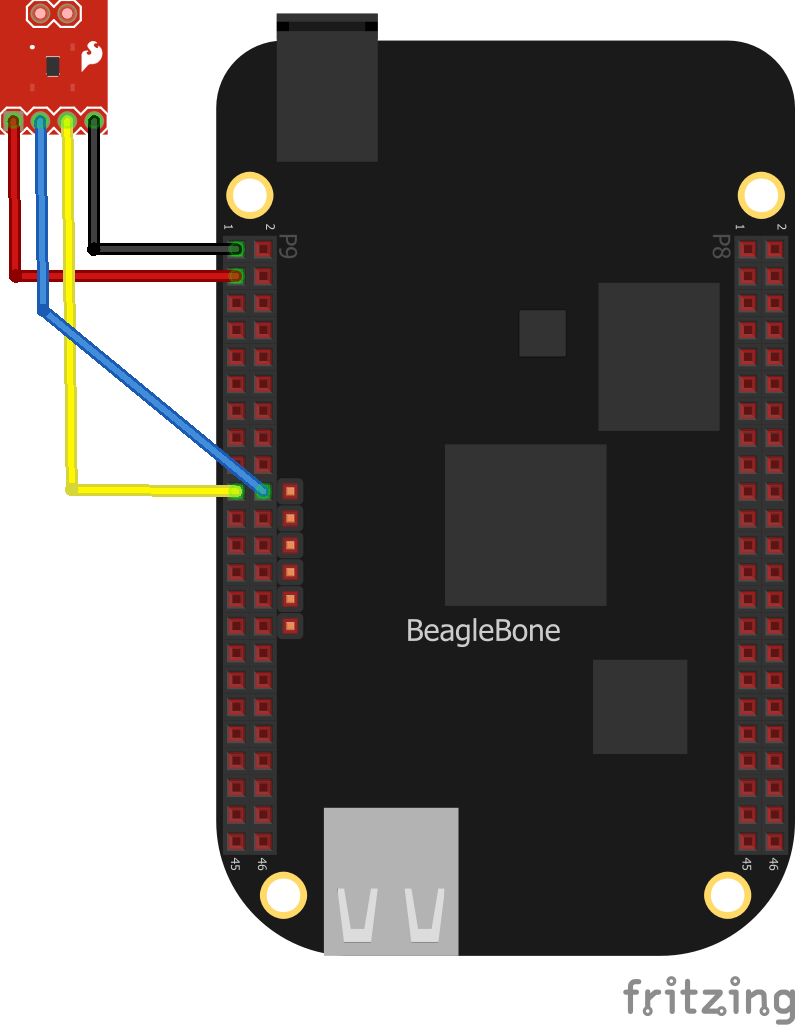In this article we look at the TMP102 digital sensor and we will connect it up to a Beaglebone
The TMP102 device is a digital temperature sensor ideal for NTC/PTC thermistor replacement where high accuracy is required. The device offers an accuracy of ±0.5°C without requiring calibration or external component signal conditioning. Device temperature sensors are highly linear and do not require complex calculations or lookup tables to derive the temperature. The on-chip 12-bit ADC offers resolutions down to 0.0625°C.
The TMP102 device features SMBus™, two-wire and I2C interface compatibility, and allows up to four devices on one bus. The device also features an SMBus alert function. The device is specified to operate over supply voltages from 1.4 to 3.6 V with the maximum quiescent current of 10 µA over the full operating range.
The TMP102 device is ideal for extended temperature measurement in a variety of communication, computer, consumer, environmental, industrial, and instrumentation applications. The device is specified for operation over a temperature range of –40°C to 125°C.
Parts List
Schematic/Connection
| Beaglebone | Module |
| 3.3v – P9.3 | Vcc |
| Gnd – P9.1 | Gnd |
| SDA – P9.20 | SDA |
| SCL – P9.19 | SCL |

Code
Modified example from https://github.com/n8many/TMP102py
[codesyntax lang=”python”]
import smbus
import time
TEMPERATURE_REG = 0x00
CONFIG_REG = 0x01
T_LOW_REG = 0x02
T_HIGH_REG = 0x03
ADDRESSES = [0x48, 0x49, 0x4A, 0x4B]
tempConvert = {
'C': lambda x: x,
'K': lambda x: x+273.15,
'F': lambda x: x*9/5+32,
'R': lambda x: (x+273.15)*9/5
}
tempConvertInv = {
'C': lambda x: x,
'K': lambda x: x-273.15,
'F': lambda x: (x-32)*5/9,
'R': lambda x: (x*5/9)-273.15
}
class TMP102(object):
def __init__(self, units=None, address=0x48, busnum=2):
units = units or 'C'
if (address not in ADDRESSES):
raise ValueError("Invalid Address: {0:#x}".format(address))
self.address = address
self.busnum = busnum
self.setUnits(units)
self.bus = smbus.SMBus(self.busnum)
self.readTemperature()
def bytesToTemp(self, data):
# Adjustment for extended mode
ext = self.extractConfig(1, 4, 1)
#ext = data[1] & 0x01
res = int((data[0] << (4+ext)) + (data[1] >> (4-ext)))
if (data[0] | 0x7F is 0xFF):
# Perform 2's complement operation (x = x-2^bits)
res = res - 4096*(2**ext)
# Outputs temperature in degC
return res*0.0625
def tempToBytes(self, temp):
# Temp MUST be converted prior to input
data = [0 , 0]
res = int(temp/0.0625)
ext = self.extractConfig(1, 4, 1)
if (res < 0):
res = res + 4096 * (2**ext)
data[0] = (res >> (4 + ext)) & 0xFF
data[1] = ((res & (2**(4 + ext)-1)) << (4 - ext)) | ext
return data
def extractConfig(self, num, location=0, length=0):
data = self.bus.read_i2c_block_data(self.address, CONFIG_REG, 2)
if (num == 3):
#Full register dump
return data
else:
mask = 2**length - 1
return (data[num] >> location) & mask
def injectConfig(self, setting, num, location, length):
mask = (2**length - 1) << location
setting = (setting << location) & mask
data = self.bus.read_i2c_block_data(self.address, CONFIG_REG, 2)
data[num] &= ~mask
data[num] |= setting
self.bus.write_i2c_block_data(self.address, CONFIG_REG, data)
def readTemperature(self, units=None):
data = self.bus.read_i2c_block_data(self.address, TEMPERATURE_REG, 2)
tempC = self.bytesToTemp(data)
units = units or self.units
try:
tempOut = tempConvert[units](tempC)
except:
raise ValueError('Invalid Units "' + self.units + '"')
return tempOut
def getUnits(self):
return self.units
def setUnits(self, units):
if (units.upper() in 'RCKF' and len(units) == 1):
self.units = units.upper()
else:
raise ValueError("Invalid Unit, must use C(elcius), K(elvin),"
"F(ahrenheit), or R(ankine)")
def setConversionRate(self, rate):
# 0 : 0.25 Hz
# 1 : 1 Hz
# 2 : 4 Hz (default)
# 3 : 8 Hz
self.injectConfig(rate, 1, 6, 2)
def setExtendedMode(self, mode):
# 0 : 12-bit ( -55C to 128C)
# 1 : 13-bit ( -55C to 150C)
self.injectConfig(mode, 1, 4, 1)
def sleep(self):
self.injectConfig(True, 0, 0, 1)
def wakeup(self):
self.injectConfig(False, 0, 0, 1)
def setAlertPolarity(self, polarity):
# 0 : Active Low
# 1 : Active High
self.injectConfig(polarity, 0, 2, 1)
def alert(self):
return extractConfig(1, 5, 1)
def setFault(self, faultSetting):
# 0 : 1 fault
# 1 : 2 faults
# 2 : 4 faults
# 3 : 6 faults
self.injectConfig(faultSetting, 0, 3, 2)
def setAlertMode(self, mode):
# 0 : Comparator Mode (Active within temp range)
# 1 : Thermostat Mode (Active if over T_High, reset on read)
self.injectConfig(mode, 0, 1, 1)
def setBoundTemp(self, upper, temperature, units=None):
units = units or self.units
ext = self.extractConfig(1, 4, 1)
try:
temperature = tempConvertInv[units](temperature)
except:
raise ValueError('Invalid Units "' + self.units + '"')
if (ext is 1 and temperature > 150):
temperature = 150
elif (temperature < -55):
temperature = -55
data = self.tempToBytes(temperature)
if (upper):
reg = T_HIGH_REG
else:
reg = T_LOW_REG
self.bus.write_i2c_block_data(self.address, reg, data)
def getBoundTemp(self, upper, units=None):
units = units or self.units
if (upper):
reg = T_HIGH_REG
else:
reg = T_LOW_REG
data = self.bus.read_i2c_block_data(self.address, reg, 2)
tempC = self.bytesToTemp(data)
try:
tempOut = tempConvert[units](tempC)
except:
raise ValueError('Invalid Units "' + self.units + '"')
return tempOut
if __name__ == "__main__":
tmp = TMP102('C', 0x48, 2)
# Actually, lets make the temperatures Farenheit
tmp.setUnits('F')
while True:
print "Current temp: {:.1f}degF".format(tmp.readTemperature())
time.sleep(1)
[/codesyntax]
Output
Run the above code. You should see something like this
debian@beaglebone:/var/lib/cloud9/$ python TMP102.py
Current temp: 71.4degF
Current temp: 71.3degF
Current temp: 71.3degF
Current temp: 71.3degF
Current temp: 74.4degF
Current temp: 77.7degF
Link
http://www.ti.com/lit/gpn/tmp102

